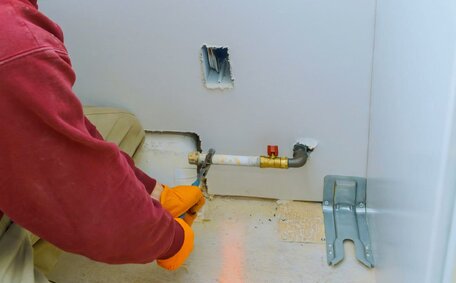Introduction: Understanding Mold Growth After Water Leaks
Mould can grow rapidly and become a grave concern, clarifying what causes mould issues within 48 hours following water damage from leaks in homes. Mould only grows when there are damp surfaces that create perfect conditions for its rapid multiplication. While various types mould are the most common, the general term encompasses fungal growth that spreads due to rising dampness and via airborne microscopic spores.
This article delves into what mould is, its common causes, and how to tackle it, focusing on identifying, preventing, and banishing mould from your home, with strategies to ensure it’s managed effectively after water leaks. We provide practical guidance to manage mould issues before they escalate into structural damage. As the leading plumbing provider in Drummoyne, Sydney, Drummoyne Plumbing can help with proactively tackling mould and mitigating associated health hazards.
Left unattended, mould infestations can cause health problems, especially where excess moisture is affecting respiratory well-being. Addressing water leaks promptly and seeking to find out more about mould development enables you to follow our outlined tips to prevent expensive mould remediation. We’ll tackle typical questions on mould detection, strategies to lessen wetness, and methods for treating areas impacted by mould in your home.
Health Risks of Mold Exposure
Exposure to any mould in poorly ventilated spaces introduces numerous health risks, as mold can cause complications for some people, particularly for groups like children, the elderly, or those with weakened immune systems.
Headaches, fatigue, rashes, respiratory distress, and allergy symptoms are common complaints, but when there is sufficient understanding on how to not let mould grow, you can help keep these issues at bay as detailed through the resources found on our website. Understanding mould and how it can affect health through microscopic spores that trigger reactions when inhaled is vital; explore this essential subject on our website. Extended exposure to mold can have different health effects, potentially affecting respiratory health and being linked to lung infections or nose and throat irritation.
If neglected, the mounting presence of mould and mildew, particularly when there’s sufficient moisture, represents significant environmental health concerns by exacerbating respiratory difficulties.
Seek medical advice if persistent flu-like symptoms persist, underscoring what to do when there is a need to prevent mould in your home with sufficient moisture for its growth, and understanding the necessary actions to take is crucial. For professional mould abatement, engage with your local department health to access licensed mold experts such as Drummoyne Plumbing, who will enter your property to examine and restore safe living conditions when there is sufficient evidence of infestation.
Preventing Mold Growth in Your Home
Since moisture establishes a foundation for damp mould conditions in your living spaces, ascertaining how to remove mould is crucial, which involves actively reducing damp-prone areas. Employ exhaust fans while cooking or showering to help prevent moisture build-up, ensuring that your vents, alongside the breeze where the air outside can permeate your domicile, reduce any mould-carrying moist air. Consider investing in dehumidifying devices to inhibit mould growth due to surface humidity air, and to assist in regulating the indoor air quality, utilising windows and vents heating air to circulate fresh air, ensuring humidity levels remain in balance.
Commence preventive steps by repairing leaky plumbing and guaranteeing that your heating, air conditioning, and ventilation systems function seamlessly to avert any stagnant water that could harbor mould inside your dwelling.
Inspect all surfaces for moisture intrusion, which can cause mould, especially after heavy rain. Dry any saturated structural materials, including those with plant or animal origins, as soon as possible to prevent mould from encroaching. Boost airflow in your house through areas like basements, to prevent environments conducive to mould propagation and to encourage air circulation.
Ensure gutters, downpipes, and walls, including blocked gutters, are thoroughly cleared of mould and debris to enable water to drain unimpeded.
Uphold sanitary habits through regular clean up routines, utilising service product treatment methodologies to expel all mould from your surfaces. While some opt to use bleach, tea tree oil solutions effectively aid in the combat against mould by inhibiting further growth and serve as safer alternatives than the hazardous mixtures when cleaning non-porous surfaces. Rinse afterwards and wipe dry to discourage regrowth.
For comprehensive mould cleaning, Drummoyne Plumbing utilises sophisticated methods which can completely reinstate affected zones, utilising the most important industry techniques, including many other parts of your home, offering advice on prevention for continued safety.
Identifying Mold Issues Early
Early recognition of mould is pivotal in stopping it before it wreaks havoc; be alert and look out for musty, earthy scents that indicate mould’s presence on your property.
Routine household evaluations are paramount for spotting tell-tale signs of mould growing in areas where your home is particularly moisture-prone, like bathrooms, basements, and kitchens. Scout for the apparent presence of any specific type mould on your walls, identifying patches of black mould which may exhibit a fuzzy texture or discolouration.
Further signs include peeling paint or warped surfaces, symptoms of water ingress, which you need to investigate thoroughly. Condensation and moisture on windowpanes may point to ventilation snags and the space’s capacity to can hold onto humidity. If unchecked, mould rapidly spreads through reproductive mould spores in the air.
If you’re figuring out how get rid of mould and its unsettling signs, don’t hesitate to contact professionals like Drummoyne Plumbing.
Our team can conduct thorough inspections using moisture metres and lab tests to identify infestation levels. We assess if mould is active or dormant and advise on how to prevent future growth. Catching issues early can take the form of more targeted, affordable treatments focused on restoring affected areas rapidly. It also reduces health risks compared to extensive, established infestations.
With sophisticated techniques and a wealth of experience in managing mould, Drummoyne Plumbing can help identify and correct mould issues early on in your home. We can also advise on improving ventilation and airflow to prevent recurrence.
Remediating Mold Damage from Water Leaks
Swift measures are vital to effective mould removal to ensure clean conditions and remediate any conditions conducive to mould growing in your environment. First, identify and address any water source that causes moisture intrusion and make necessary repairs to eliminate ongoing dampness. Wear protective gear such as gloves, goggles, and masks when cleaning to ensure your protection from spore inhalation.
Use fans, dehumidifiers or open windows to dry out affected areas rapidly. Use fans, dehumidifiers or open windows to dry out affected areas rapidly. Use fans, dehumidifiers or open windows to dry out affected areas rapidly.
Belongings like clothing shoes, and other personal items with mould colonies might require replacement after flood, while surfaces such as impermeable surfaces can often be thoroughly cleaned.
Follow treatment by drying surfaces thoroughly, as any lingering humidity in the air lets mould return. Seek professional help from Drummoyne Plumbing, especially if you have taken measures but are faced with more extensive infestations impacting multiple rooms or structural elements. Our remediation solutions fully restore affected homes while consulting on preventative measures against recurrence.
Closely monitor roofs walls including all areas, even those blocked from regular inspection, for any signs of regrowth over the subsequent weeks.
Hiring a Professional for Severe Mold Problems
In certain situations, mould issues can escalate beyond what typical DIY solutions can address. Extensive mould growth that impacts multiple rooms or structural elements often requires professional remediation. Symptoms like respiratory distress, severe allergy attacks or flu-like illness may also indicate severe infestation where expert assistance is advisable.
For major mould issues in your rental property, where it’s commonly found, enlist qualified specialists like Drummoyne Plumbing. Our extensive experience allows us to fully rehabilitate affected properties using powerful sanitization techniques and moisture control solutions unavailable to homeowners. We conduct comprehensive inspections to identify all contaminated areas and determine necessary repairs to prevent recurrence.
By tackling issues early before they worsen, we can resolve most mould intrusions more than affordably. However, neglected infestations often lead to costly rebuilds. Don’t delay - prioritise your health and home by contacting Drummoyne Plumbing.
Our responsive team is ready to inspect your property diligently to prevent mold and restore safe living conditions after severe mould exposure.Get in touch today via email on jobs@drummoyneplumbingservices.com.au, book an appointment online or call 1300 349 338.
Preventing Recurrent Mold Growth Long-Term
To stop mould from recurring long-term, consistency is key with regular inspections, prompt response to moisture/leaks, and maintaining airflow. Check air conditioning systems and all other structures monthly for condensation, musty smells or visible signs of mould.
Deal with any plumbing leaks or seeping fixtures promptly, effectively averting what can do harm if air conditioner issues contribute to mould problems that are left to fester. Ensure effective airflow by using fans, dehumidifiers, and inviting currents into your home through open windows vents heating, to fend off stagnant airs that cultivate mould reproduction. Humidity levels between 30-50% discourage mould while allowing healthy air circulation.
When renovating or repairing water-damaged areas, use materials such as mould-resistant building materials like metal, tile or mould-killing paints. Never let repairs wait when it comes to potential mould hazards. Ongoing diligence to keep your home mould-free ensures it doesn’t gain a foothold again.
For professional support and guidance on mould prevention and everything you need to know about managing humidity or insulating your home, contact Drummoyne Plumbing. Our comprehensive assessments, which involve more than 10 critical checks, identify vulnerabilities, with solutions to reinforce affected structures against moisture enabling mould regrowth.






